人工智能—Python實現線性回歸
1、概述
(1)人工智能學習
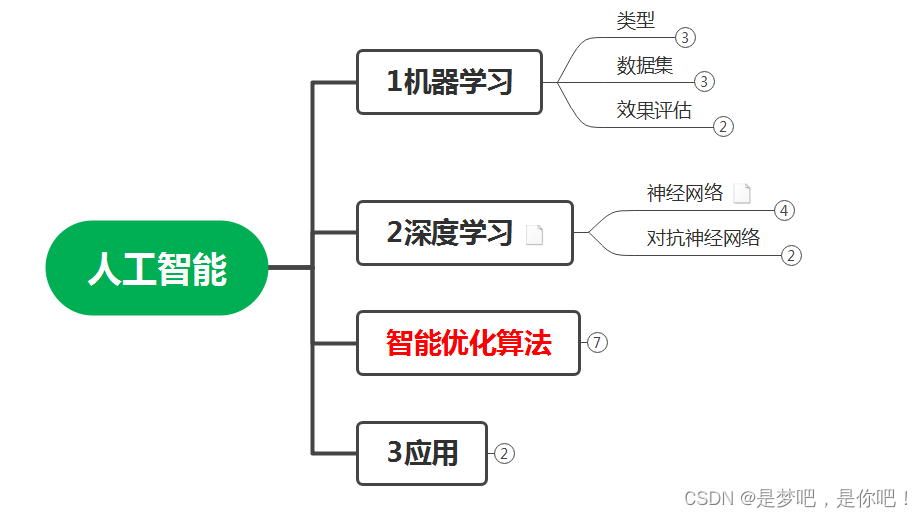
(2)機器學習
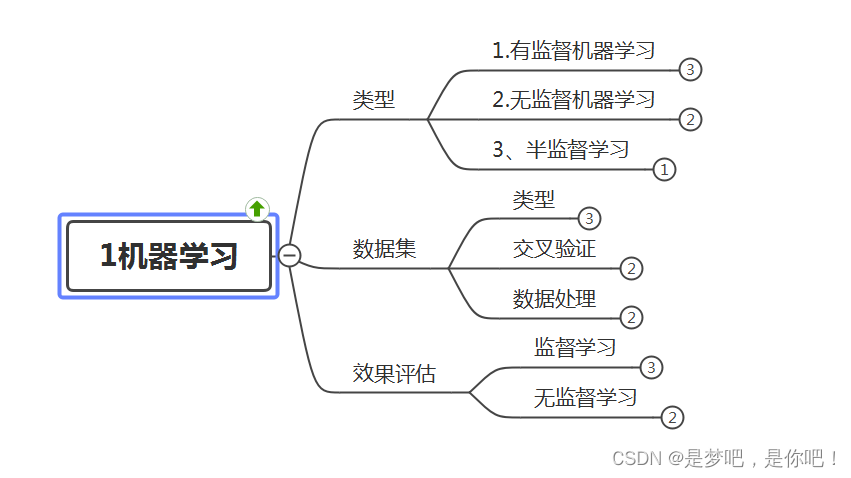
(3)有監督學習
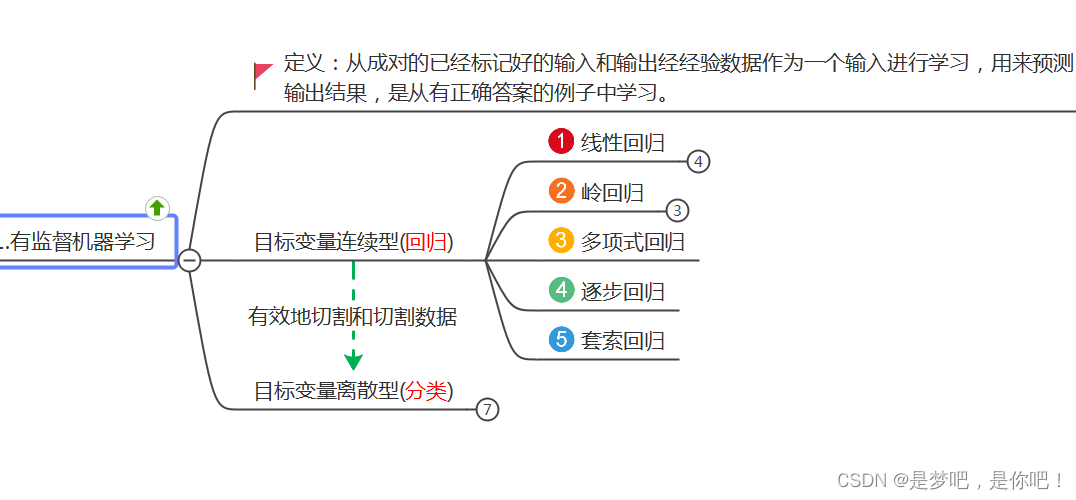
(4)線性回歸
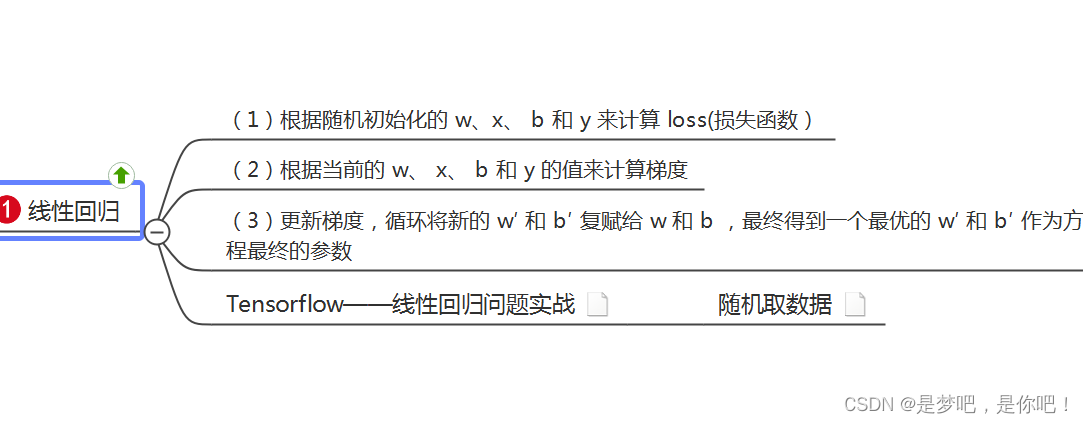
2、線性回歸
(1)實現步驟
- 根據隨機初始化的 w x b 和 y 來計算 loss
- 根據當前的 w x b 和 y 的值來計算梯度
- 更新梯度,循環將新的 w′ 和 b′ 復賦給 w 和 b ,最終得到一個最優的 w′ 和 b′ 作為方程最終的
(2)數學表達式
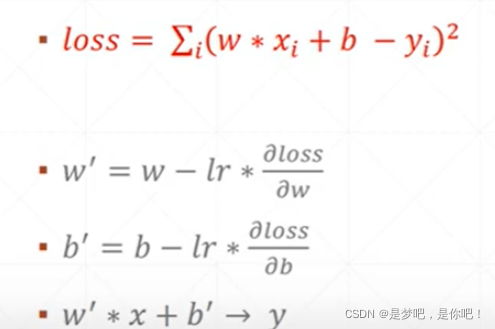
3、代碼實現(Python)
(1)機器學習庫(sklearn.linear_model)
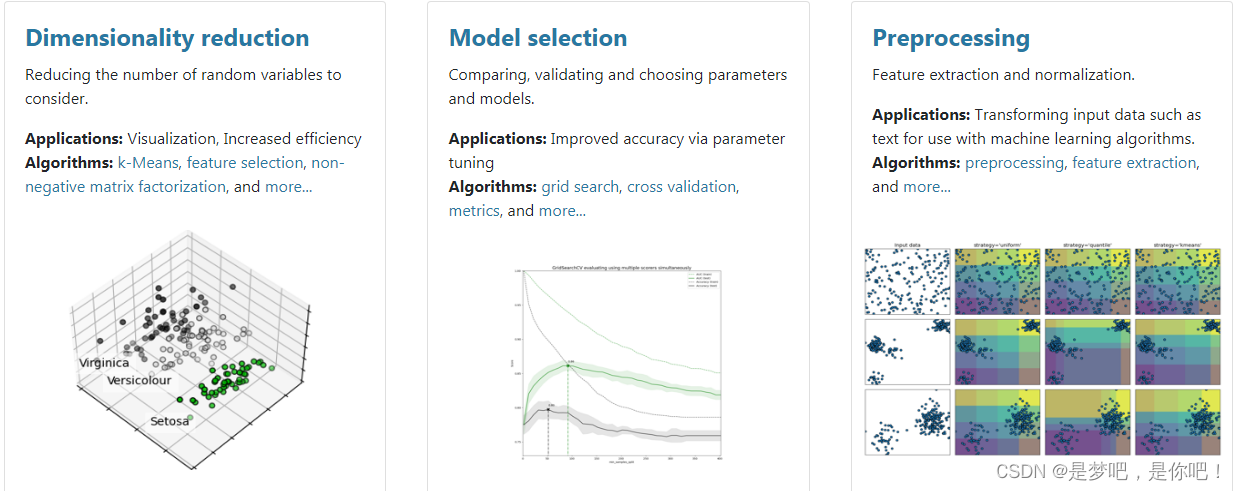
代碼:
from sklearn import linear_model
from sklearn.linear_model import LinearRegression
import matplotlib.pyplot as plt#用於作圖
from pylab import *
mpl.rcParams['font.sans-serif'] = ['SimHei']
mpl.rcParams['axes.unicode_minus'] = False
import numpy as np#用於創建向量
reg=linear_model.LinearRegression(fit_intercept=True,normalize=False)
x=[[32.50235],[53.4268],[61.53036],[47.47564],[59.81321],[55.14219],[52.14219],[39.29957],
[48.10504],[52.55001],[45.41873],[54.35163],[44.16405],[58.16847],[56.72721]]
y=[31.70701,68.7776,62.56238,71.54663,87.23093,78.21152,79.64197,59.17149,75.33124,71.30088,55.16568,82.47885,62.00892
,75.39287,81.43619]
reg.fit(x,y)
k=reg.coef_#獲取斜率w1,w2,w3,...,wn
b=reg.intercept_#獲取截距w0
x0=np.arange(30,60,0.2)
y0=k*x0+b
print("k={0},b={1}".format(k,b))
plt.scatter(x,y)
plt.plot(x0,y0,label='LinearRegression')
plt.xlabel('X')
plt.ylabel('Y')
plt.legend()
plt.show()
結果:
k=[1.36695374],b=0.13079331831460195
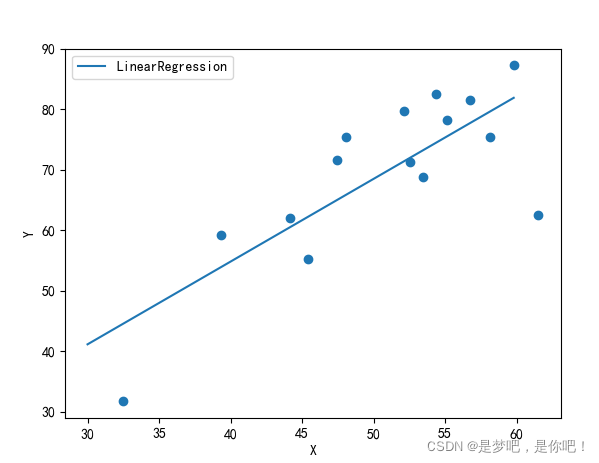
(2)Python詳細實現(方法1)

代碼:
#方法1
import numpy as np
import matplotlib.pyplot as plt
from pylab import *
mpl.rcParams['font.sans-serif'] = ['SimHei']
mpl.rcParams['axes.unicode_minus'] = False
#數據生成
data = []
for i in range(100):
x = np.random.uniform(3., 12.)
# mean=0, std=1
eps = np.random.normal(0., 1)
y = 1.677 * x + 0.039 + eps
data.append([x, y])
data = np.array(data)
#統計誤差
# y = wx + b
def compute_error_for_line_given_points(b, w, points):
totalError = 0
for i in range(0, len(points)):
x = points[i, 0]
y = points[i, 1]
# computer mean-squared-error
totalError += (y - (w * x + b)) ** 2
# average loss for each point
return totalError / float(len(points))
#計算梯度
def step_gradient(b_current, w_current, points, learningRate):
b_gradient = 0
w_gradient = 0
N = float(len(points))
for i in range(0, len(points)):
x = points[i, 0]
y = points[i, 1]
# grad_b = 2(wx+b-y)
b_gradient += (2/N) * ((w_current * x + b_current) - y)
# grad_w = 2(wx+b-y)*x
w_gradient += (2/N) * x * ((w_current * x + b_current) - y)
# update w'
new_b = b_current - (learningRate * b_gradient)
new_w = w_current - (learningRate * w_gradient)
return [new_b, new_w]
#迭代更新
def gradient_descent_runner(points, starting_b, starting_w, learning_rate, num_iterations):
b = starting_b
w = starting_w
# update for several times
for i in range(num_iterations):
b, w = step_gradient(b, w, np.array(points), learning_rate)
return [b, w]
def main():
learning_rate = 0.0001
initial_b = 0 # initial y-intercept guess
initial_w = 0 # initial slope guess
num_iterations = 1000
print("迭代前 b = {0}, w = {1}, error = {2}"
.format(initial_b, initial_w,
compute_error_for_line_given_points(initial_b, initial_w, data))
)
print("Running...")
[b, w] = gradient_descent_runner(data, initial_b, initial_w, learning_rate, num_iterations)
print("第 {0} 次迭代結果 b = {1}, w = {2}, error = {3}".
format(num_iterations, b, w,
compute_error_for_line_given_points(b, w, data))
)
plt.plot(data[:,0],data[:,1], color='b', marker='+', linestyle='--',label='true')
plt.plot(data[:,0],w*data[:,0]+b,color='r',label='predict')
plt.xlabel('X')
plt.ylabel('Y')
plt.legend()
plt.show()
if __name__ == '__main__':
main()
結果:
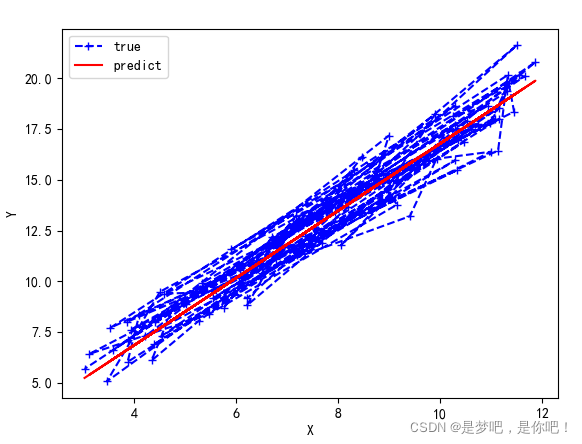
迭代前 :b = 0, w = 0, error = 186.61000821356697
Running…
第 1000 次迭代結果:b = 0.20558501549252192, w = 1.6589067569038516, error = 0.9963685680112963
(3)Python詳細實現(方法2)
代碼:
#方法2
import numpy as np
import pandas as pd
import matplotlib.pyplot as plt
import matplotlib as mpl
mpl.rcParams["font.sans-serif"]=["SimHei"]
mpl.rcParams["axes.unicode_minus"]=False
# y = wx + b
#Import data
file=pd.read_csv("data.csv")
def compute_error_for_line_given(b, w):
totalError = np.sum((file['y']-(w*file['x']+b))**2)
return np.mean(totalError)
def step_gradient(b_current, w_current, learningRate):
b_gradient = 0
w_gradient = 0
N = float(len(file['x']))
for i in range (0,len(file['x'])):
# grad_b = 2(wx+b-y)
b_gradient += (2 / N) * ((w_current * file['x'] + b_current) - file['y'])
# grad_w = 2(wx+b-y)*x
w_gradient += (2 / N) * file['x'] * ((w_current * file['x'] + b_current) - file['x'])
# update w'
new_b = b_current - (learningRate * b_gradient)
new_w = w_current - (learningRate * w_gradient)
return [new_b, new_w]
def gradient_descent_runner( starting_b, starting_w, learning_rate, num_iterations):
b = starting_b
w = starting_w
# update for several times
for i in range(num_iterations):
b, w = step_gradient(b, w, learning_rate)
return [b, w]
def main():
learning_rate = 0.0001
initial_b = 0 # initial y-intercept guess
initial_w = 0 # initial slope guess
num_iterations = 100
print("Starting gradient descent at b = {0}, w = {1}, error = {2}"
.format(initial_b, initial_w,
compute_error_for_line_given(initial_b, initial_w))
)
print("Running...")
[b, w] = gradient_descent_runner(initial_b, initial_w, learning_rate, num_iterations)
print("After {0} iterations b = {1}, w = {2}, error = {3}".
format(num_iterations, b, w,
compute_error_for_line_given(b, w))
)
plt.plot(file['x'],file['y'],'ro',label='線性回歸')
plt.xlabel('X')
plt.ylabel('Y')
plt.legend()
plt.show()
if __name__ == '__main__':
main()
結果:
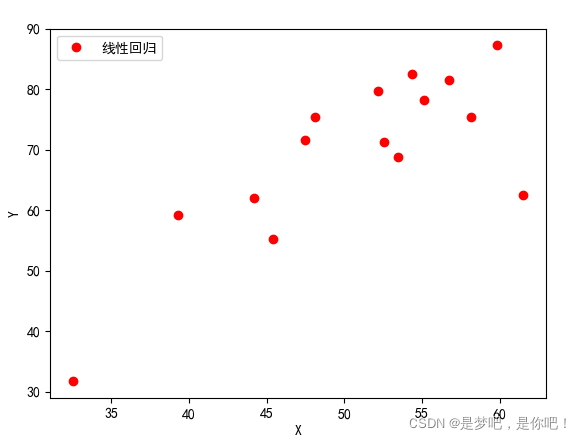
Starting gradient descent at b = 0, w = 0, error = 75104.71822821398 Running... After 100 iterations b = 0 0.014845 1 0.325621 2 0.036883 3 0.502265 4 0.564917 5 0.479366 6 0.568968 7 0.422619 8 0.565073 9 0.393907 10 0.216854 11 0.580750 12 0.379350 13 0.361574 14 0.511651 dtype: float64, w = 0 0.999520 1 0.994006 2 0.999405 3 0.989645 4 0.990683 5 0.991444 6 0.989282 7 0.989573 8 0.988498 9 0.992633 10 0.995329 11 0.989490 12 0.991617 13 0.993872 14 0.991116 dtype: float64, error = 6451.5510231710905
數據:
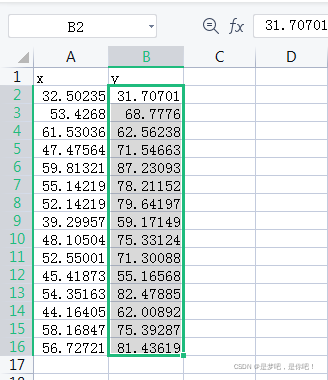
(4)Python詳細實現(方法3)
#方法3
import numpy as np
points = np.genfromtxt("data.csv", delimiter=",")
#從數據讀入到返回需要兩個迭代循環,第一個迭代將文件中每一行轉化為一個字符串序列,
#第二個循環迭代對每個字符串序列指定合適的數據類型:
# y = wx + b
def compute_error_for_line_given_points(b, w, points):
totalError = 0
for i in range(0, len(points)):
x = points[i, 0]
y = points[i, 1]
# computer mean-squared-error
totalError += (y - (w * x + b)) ** 2
# average loss for each point
return totalError / float(len(points))
def step_gradient(b_current, w_current, points, learningRate):
b_gradient = 0
w_gradient = 0
N = float(len(points))
for i in range(0, len(points)):
x = points[i, 0]
y = points[i, 1]
# grad_b = 2(wx+b-y)
b_gradient += (2 / N) * ((w_current * x + b_current) - y)
# grad_w = 2(wx+b-y)*x
w_gradient += (2 / N) * x * ((w_current * x + b_current) - y)
# update w'
new_b = b_current - (learningRate * b_gradient)
new_w = w_current - (learningRate * w_gradient)
return [new_b, new_w]
def gradient_descent_runner(points, starting_b, starting_w, learning_rate, num_iterations):
b = starting_b
w = starting_w
# update for several times
for i in range(num_iterations):
b, w = step_gradient(b, w, np.array(points), learning_rate)
return [b, w]
def main():
learning_rate = 0.0001
initial_b = 0 # initial y-intercept guess
initial_w = 0 # initial slope guess
num_iterations = 1000
print("Starting gradient descent at b = {0}, w = {1}, error = {2}"
.format(initial_b, initial_w,
compute_error_for_line_given_points(initial_b, initial_w, points))
)
print("Running...")
[b, w] = gradient_descent_runner(points, initial_b, initial_w, learning_rate, num_iterations)
print("After {0} iterations b = {1}, w = {2}, error = {3}".
format(num_iterations, b, w,
compute_error_for_line_given_points(b, w, points))
)
if __name__ == '__main__':
main()
4、案例——房屋與價格、尺寸

(1)代碼
#1.導入包
import matplotlib.pyplot as plt
import numpy as np
import pandas as pd
from sklearn import linear_model
#2.加載訓練數據,建立回歸方程
# 取數據集(1)
datasets_X = [] #存放房屋面積
datasets_Y = [] #存放交易價格
fr = open('房價與房屋尺寸.csv','r') #讀取文件,r: 以隻讀方式打開文件,w: 打開一個文件隻用於寫入。
lines = fr.readlines() #一次讀取整個文件。
for line in lines: #逐行進行操作,循環遍歷所有數據
items = line.strip().split(',') #去除數據文件中的逗號,strip()用於移除字符串頭尾指定的字符(默認為空格或換行符)或字符序列。
#split(‘ '): 通過指定分隔符對字符串進行切片,如果參數 num 有指定值,則分隔 num+1 個子字符串。
datasets_X.append(int(items[0])) #將讀取的數據轉換為int型,並分別寫入
datasets_Y.append(int(items[1]))
length = len(datasets_X) #求得datasets_X的長度,即為數據的總數
datasets_X = np.array(datasets_X).reshape([length,1]) #將datasets_X轉化為數組,並變為1維,以符合線性回歸擬合函數輸入參數要求
datasets_Y = np.array(datasets_Y) #將datasets_Y轉化為數組
#取數據集(2)
'''fr = pd.read_csv('房價與房屋尺寸.csv',encoding='utf-8')
datasets_X=fr['房屋面積']
datasets_Y=fr['交易價格']'''
minX = min(datasets_X)
maxX = max(datasets_X)
X = np.arange(minX,maxX).reshape([-1,1]) #以數據datasets_X的最大值和最小值為范圍,建立等差數列,方便後續畫圖。
#reshape([-1,1]),轉換成1列,reshape([2,-1]):轉換成兩行
linear = linear_model.LinearRegression() #調用線性回歸模塊,建立回歸方程,擬合數據
linear.fit(datasets_X, datasets_Y)
#3.斜率及截距
print('Coefficients:', linear.coef_) #查看回歸方程系數(k)
print('intercept:', linear.intercept_) ##查看回歸方程截距(b)
print('y={0}x+{1}'.format(linear.coef_,linear.intercept_)) #擬合線
# 4.圖像中顯示
plt.scatter(datasets_X, datasets_Y, color = 'red')
plt.plot(X, linear.predict(X), color = 'blue')
plt.xlabel('Area')
plt.ylabel('Price')
plt.show()
(2)結果
Coefficients: [0.14198749] intercept: 53.43633899175563 y=[0.14198749]x+53.43633899175563
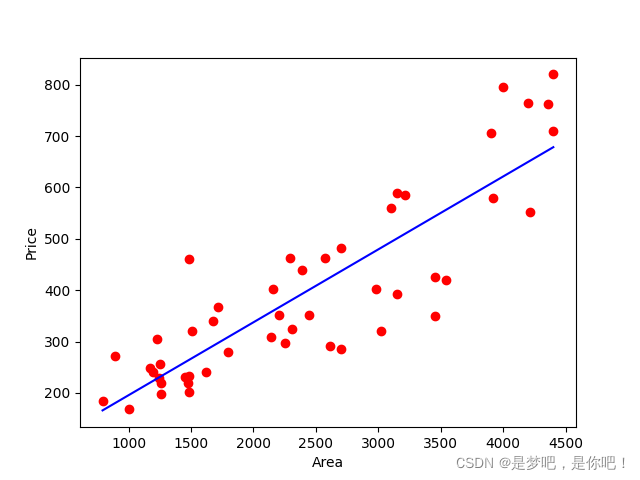
(3)數據
第一列是房屋面積,第二列是交易價格:
到此這篇關於人工智能—Python實現線性回歸的文章就介紹到這瞭,更多相關 Python實現線性回歸內容請搜索WalkonNet以前的文章或繼續瀏覽下面的相關文章希望大傢以後多多支持WalkonNet!